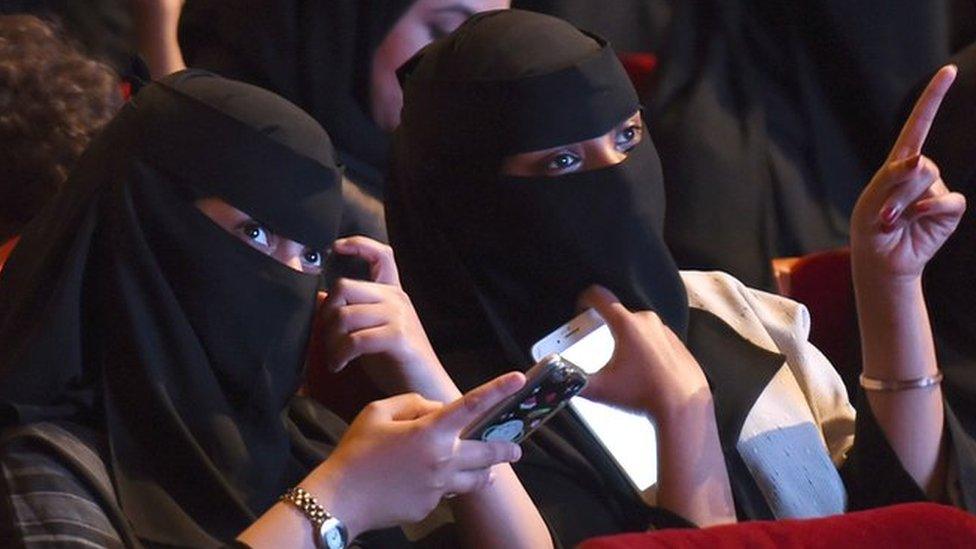Saudi artists confront change as kingdom shifts
- Published
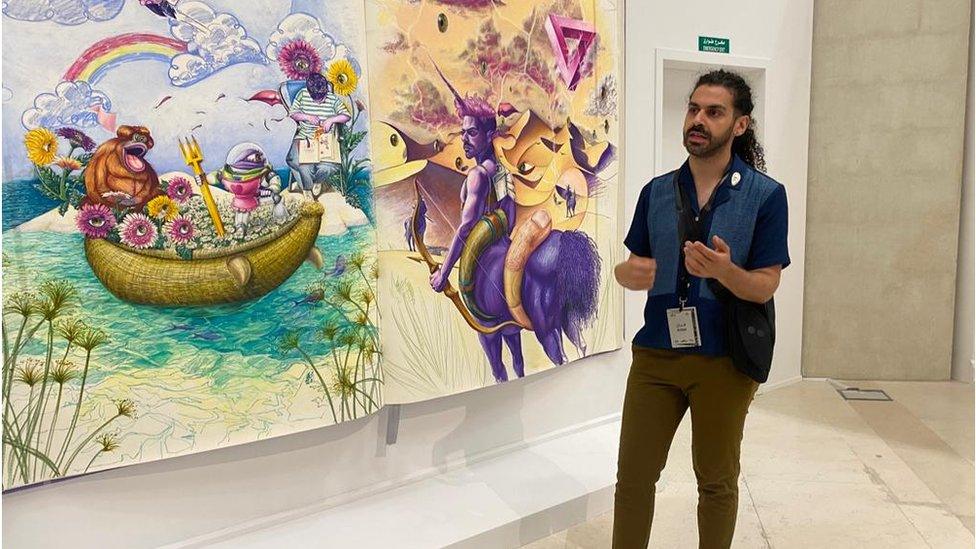
Art like Obadah Al-Jefri's paintings is considered more acceptable now than in the past
"As a child sleeping in the back of my parents' car, I used to know I was almost home by the smell of the palm groves on the edge of town," remembers Ghassan Al-Khunaizi, a poet born and bred in the city of Qatif in the Eastern Province of Saudi Arabia.
He's speaking in the house of his friend, the artist Hussein Al-Mohasen. The building is due to be demolished as the remorseless march of modernisation continues in the Kingdom. A new four-lane highway will be built through the neighbourhood.
Both are sanguine about this, saying that full compensation is being offered and that such projects are needed to make life easier in the town.
As they stand in a large room filled to bursting with paintings, lithographs and books, they say that the concrete memories that will be lost will remain preserved in their heads and in their art. The palm groves that Ghassan remembers from his childhood in the 1960s are already long gone.
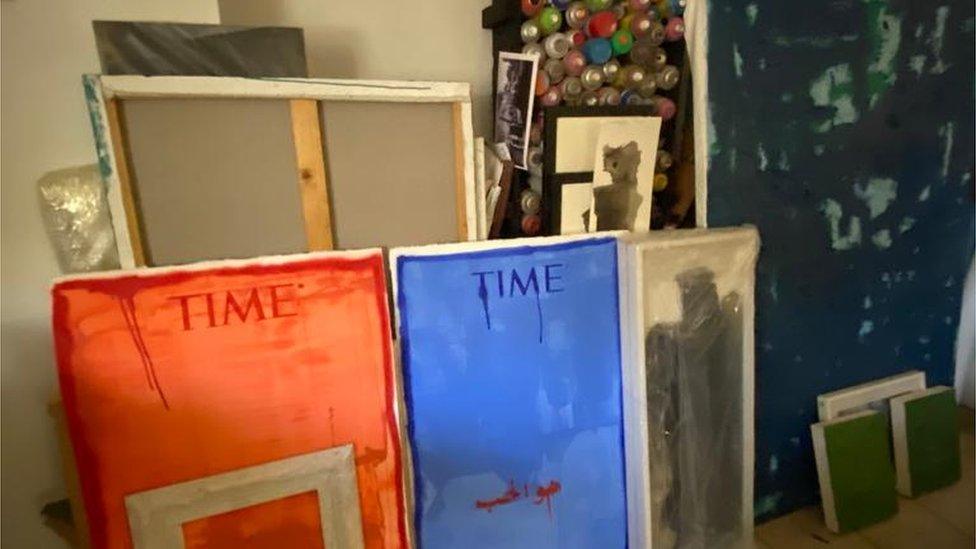
Canvases in the studio of artist Hussein Al-Mohasen in Qatif
Forty-five minutes' drive away, a vast museum complex is hosting some of their recent work in an exhibition uniting Saudi artists from the east and west of the country in an examination of what the concept of place - makan in Arabic - means to them.
The vast edifice rises on the edge of a highway on the outskirts of Al-Khobar - one of the three conjoined cities with Dhahran and Dammam on the Gulf coast. The design is intended to echo the landscape, as if five huge boulders had been brought together to make a shelter in the escarpment. To the casual observer, the first impression may seem more reminiscent of something a little less rarefied.
The King Abdulaziz Centre for World Culture - known as Ithra - dates back a decade, long before the helter skelter pace of cultural and social transformation that's been seen in the past few years under Crown Prince Mohammed bin Salman. Saudis and expatriates flock to it late into the evening to enjoy its lavish galleries on natural history, Islam and modern art as a lone musician plays the oud in the vast entrance hall.
The Centre's newly appointed head, Abdullah al-Rashid, says that Ithra was a visionary pioneer in the arts and culture scene of Saudi Arabia, just ahead of the curve as the country began to emerge from a deeply conservative form of Islam in which there were spoken or unspoken bans on most forms of artistic expression.
A tall, Adam Driver lookalike, al-Rashid, says the centre was designed to be ready when change came - for instance, installing a state of the art cinema in the complex at a time when showing films in public places in Saudi Arabia still seemed a pipe dream.
Now, cinemas abound across the Kingdom - with a huge variety of entertainment on tap in the major cities. But al-Rashid says the aim of the institution he now heads has never been to push boundaries or to provoke, but to help broaden the space in which art and culture can develop in Saudi Arabia.
'Ode to the past'
On the other side of the high columned public spaces of the centre - past a children's museum and an interactive exhibit on traditional melodies sung during Ramadan - the Amakin exhibition exemplifies this approach.
Its organiser, Venetia Porter - who's curator of Islamic and Contemporary Middle East art at the British Museum - says she decided on the theme after being told of a famous song with the same title by the renowned Saudi singer Mohammed Abdu. Its doleful rhythm rings out as a group of artists describe how they have tried to find their place in a country that once had little time for such self expression, but now pours huge amounts of state cash into evolving a modern culture that stays within certain limits.
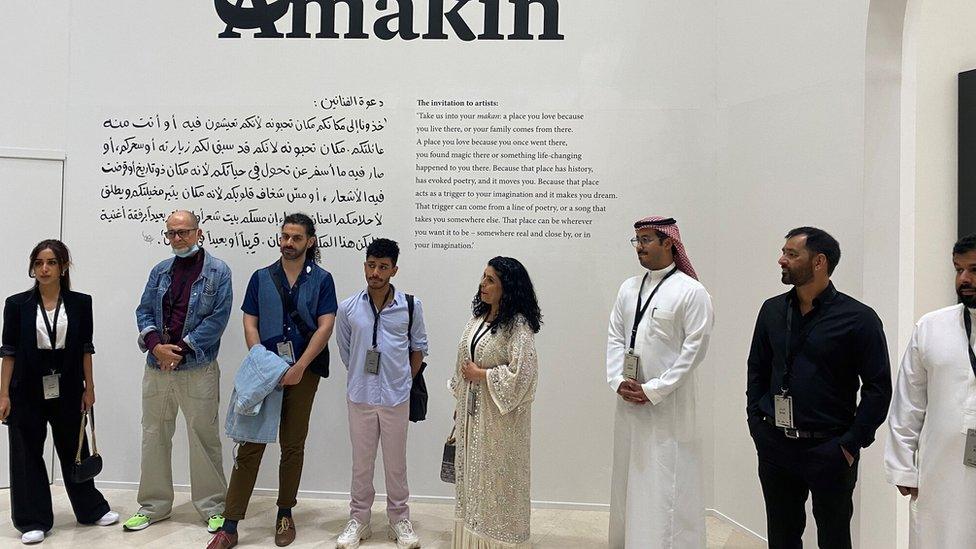
Saudi artists at the Amakin exhibition
The photographer Bader Awwad al-Balawi has been documenting his own surroundings in Khobar - the apparent mundanity of the 1960s and 1970s architecture that is fraying and partly abandoned in the centre and the lives that are still led there. Another artist, who goes by the name of Emy Kat, has done something similar for Jeddah.
Kat - who's led a picaresque life from entrepreneurial tycoon in 1980s Saudi Arabia to fashion photographer in the US and now conceptual artist - lived for several months in al-Balad, the old centre of Jeddah which is currently being demolished district by district.
An abstract blue and white composition reflects the walls of Jeddah - a city known as the Bride of the Red Sea. Kat says the blue represents water and white is for the bridal dress.
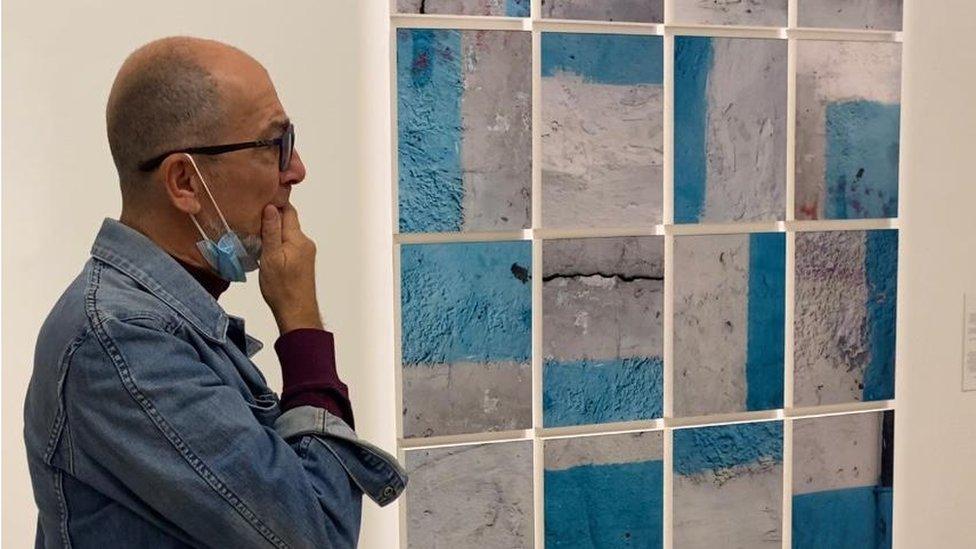
Emy Kat with his composition of Jeddah
In the same room is another horizontal wall formed from rubble found in al-Balad with handwritten messages in gold leaf inserted between each fragment by the artist Asma Bahmim.
Soon, artworks like this may be all that remains of what was once the commercial heart of Jeddah.
The authorities have written off such areas as slums - not the still vibrant areas freighted with memory whose loss its residents lament, while Saudi artists seek ways to capture some trace of its essence in their work.
Children, witches and a neon-lit ice cream truck feature in a fever dream of nostalgia in a short film by the Jeddah-born director Mohammed Hammad, which he describes as "my ode to this once amazing place of wonders that is a phantom of the past in our memories".
Another dreamlike landscape - which not long ago might have seemed perhaps dangerously out of place in Saudi Arabia - is contained in a large, brash painting by another young artist born in Jeddah, Obadah Al-Jefri, which features a purple centaur, powder puff girls and sand dunes with watchful eyes set within them.
Al-Jefri was nervous about presenting in public a picture that so exposes his inner self: "It navigates themes of masculinity and femininity and other points of my identity." The artist - who still lives in Jeddah - draws attention to the title: Impossible Selves.
Dual realities
Back in Qatif, a small remnant of the old town survives precariously - wooden shutters inside an abandoned house shudder slightly as a furnace hot breeze blows through the dust drenched interior.
No-one is sure what will happen to it. Its mud brick walls have been patched over with concrete - a temporary measure that only ensures the cracks grow ever larger.
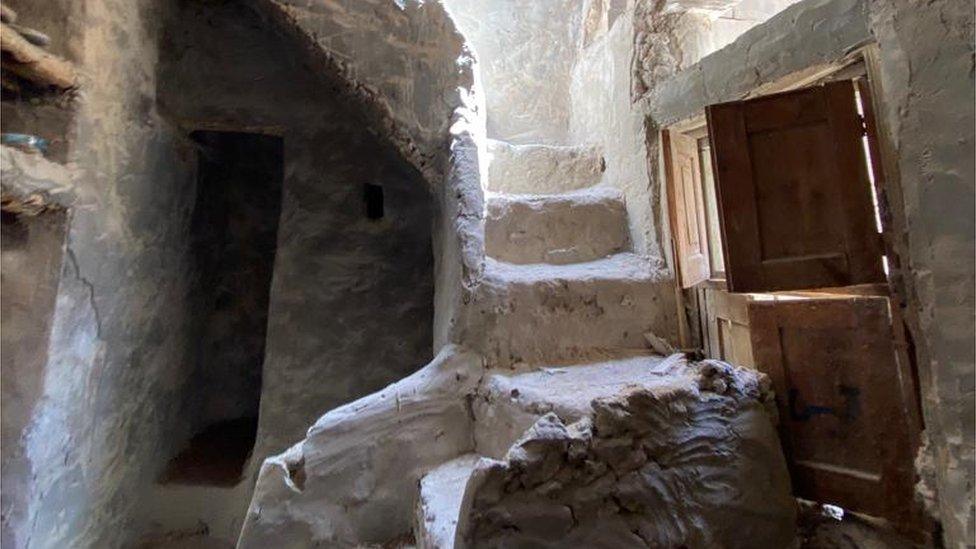
Ramshackle dwelling in Old Qatif
Qatif is an ancient settlement stretching back more than 3,000 years - such pre-Islamic history was once ignored in Saudi Arabia, but is now explored as part of a reset of the national identity.
The area is home to much of the country's Shia minority - and has seen regular unrest. Mass executions in Saudi Arabia that have roused international condemnation have involved locals accused of terrorism.
The town at the centre of major protests several years ago, Al Awamiyah, is a short drive away. Its old quarter has been demolished - the authorities said it was for renovation and renewal, but its destruction was resisted by local residents. That is a darker aspect of what the concept of place - makan - means in the Kingdom.
The place of Saudi Arabia itself in the world remains double-edged. As President Biden prepares for an official visit this month, the country continues to be perceived by many outside within the shadow of the killing of Jamal Khashoggi, while inside the country, change is undeniable for a young population that appears to welcome it.
Those covering Saudi Arabia are still caught between these two opposing poles, trying to find a way to describe the country that acknowledges both realities.
Ten years ago, the simple desire of a Saudi girl to be allowed to ride a bike was the central theme of the first feature film directed by a Saudi woman, Wadjda, which brought international attention and praise for what was a ground-breaking expression of identity and place in the Kingdom.
Now, on the corniche by the Gulf on Tarout island to the edge of Khobar, a young girl in a black headscarf sits poised on her bicycle, awaiting her future.


You may also be interested in:
Whole areas of Saudi Arabia's second city are being razed to make way for a new development.
Related topics
- Published11 March 2022
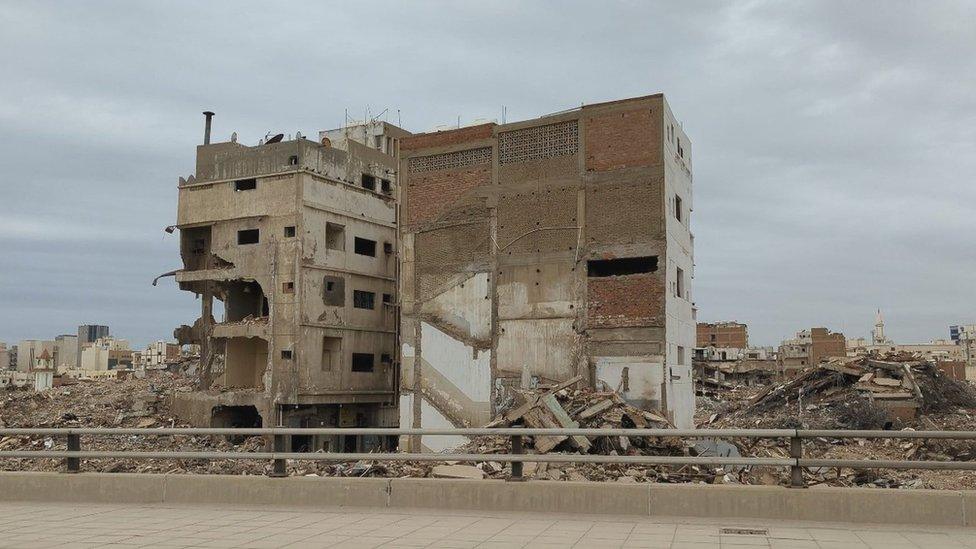
- Published2 December 2019
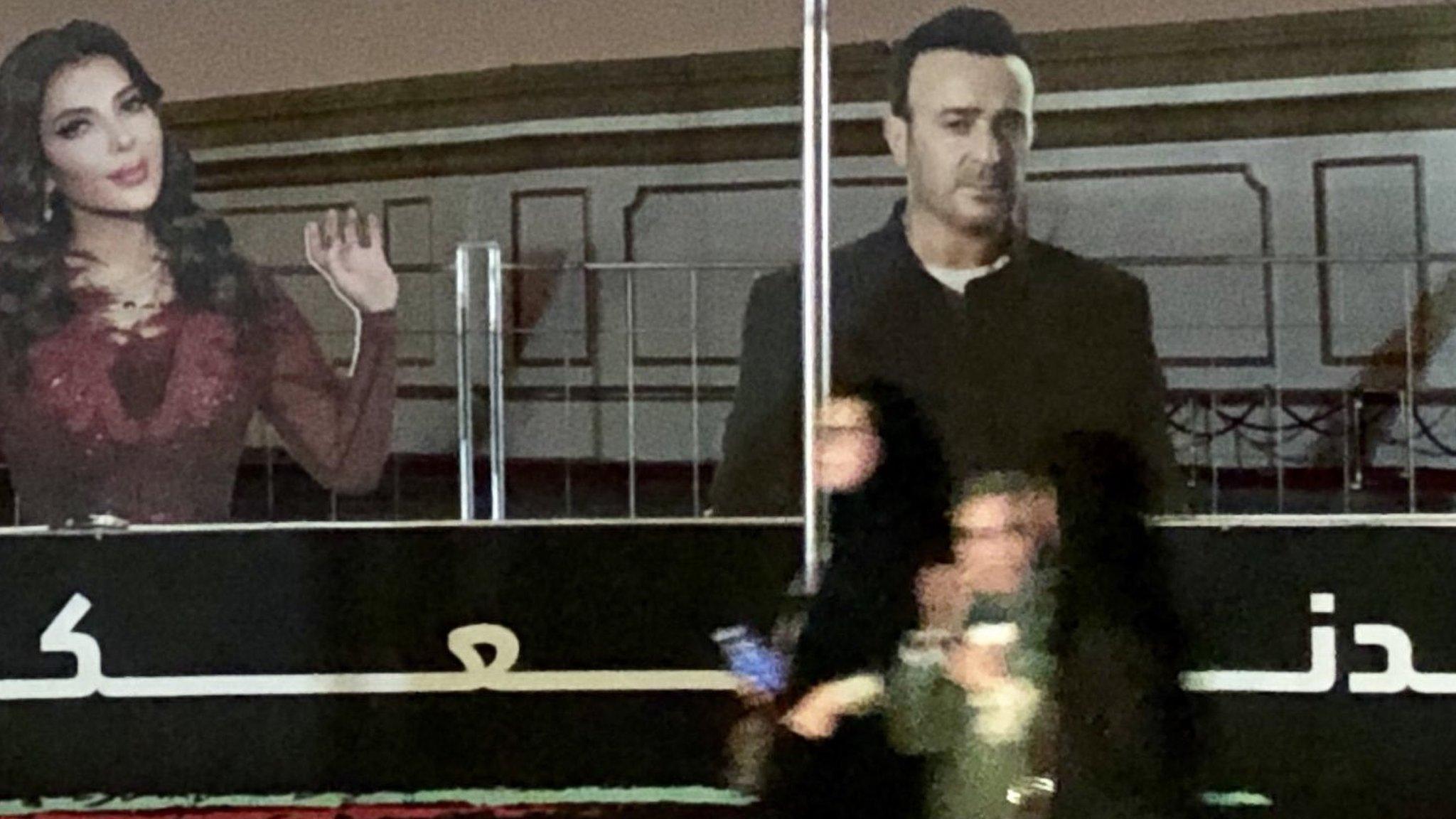
- Published4 August 2019

- Published17 April 2018
